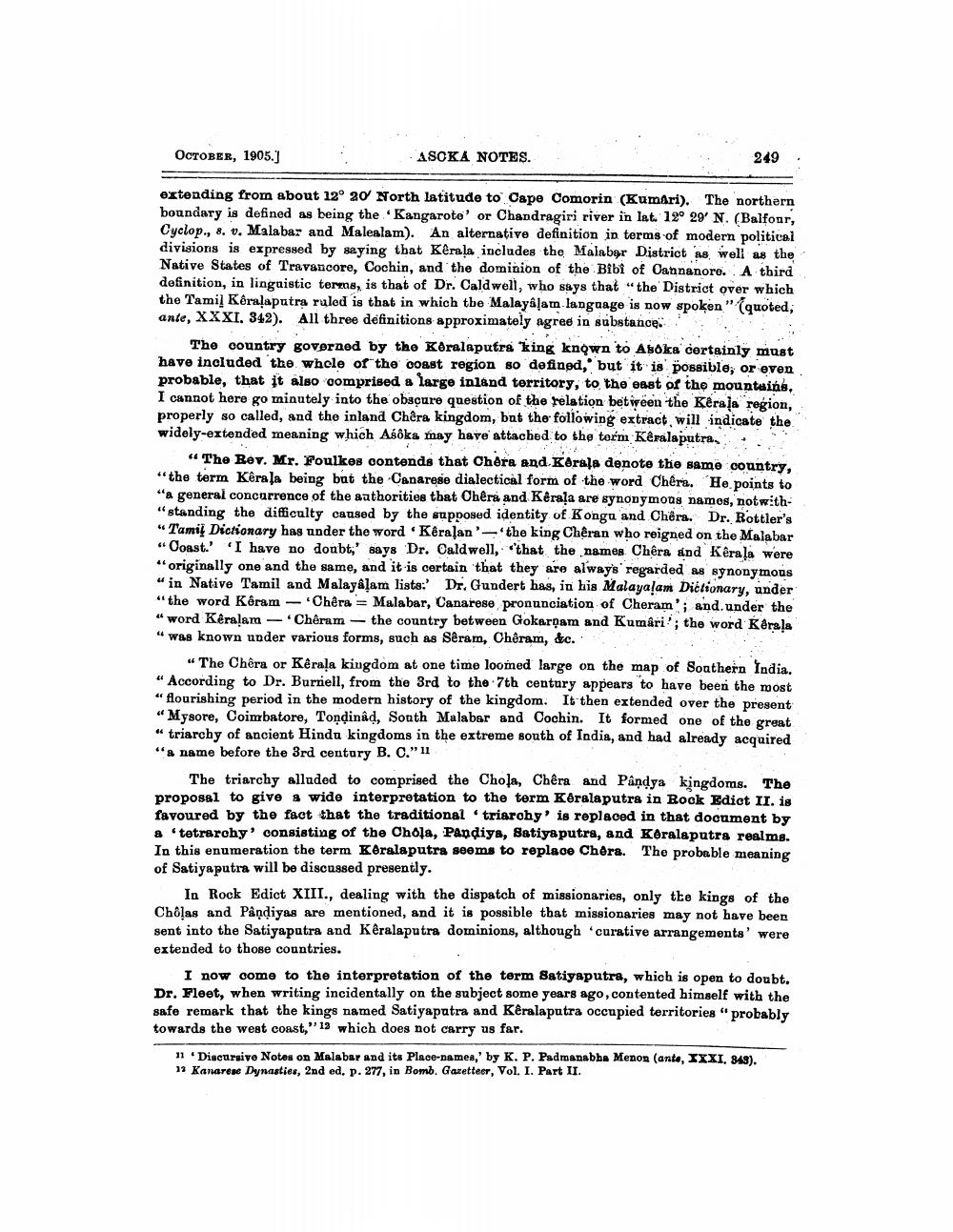________________
OCTOBER, 1905.)
ASOKA NOTES.
249
extending from about 12° 20 North latitude to Cape Comorin (Kumari). The northern boundary is defined as being the Kangarote' or Chandragiri river in lat. 12° 29' N. (Balfour, Cyclop., 8. v. Malabar and Malealam). An alternative definition in terms of modern political divisions is expressed by saying that Kerala includes the Malabar District as well as the Native States of Travancore, Cochin, and the dominion of the Bibi of Cannanore. A third definition, in linguistic termas, is that of Dr. Caldwell, who says that the District over which the Tamil Kêra?aputra ruled is that in which the Malayalam language is now spoken" (quoted, ante, XXXI, 342). All three definitions approximately agree in substance.
The country governed by the Koralaputra 'king known to Asoka certainly must have included the whole of the coast region so defined, but it is possible, or even probable, that it also comprised a large inland territory, to the east of the mountains, I cannot here go minutely into the obscure question of the relation between the Kerala region, properly so called, and the inland Chêra kingdom, but the following extract will indicate the widely-extended meaning which Asöks may have attached to the term Keralaputra,
"The Rev. Mr. Foulkes contends that Chera and Kerala denote the same country, **the term Kêra la being but the Canarese dialectical form of the word Chére. He points to "a general concurrence of the authorities that Chêra and Kerala are synonymous names, notwith"standing the difficulty caused by the supposed identity of Kongu and Chêra. Dr. Rottler's "Tamil Dictionary has under the word Kêraļan' 'the king Chêran who reigned on the Malabar "Coast. I have no doubt;' says Dr. Caldwell, that the names Chêra and Kerala were "originally one and the same, and it is certain that they are always regarded as synonymous "in Native Tamil and Malayalam lists:' Dr. Gundert has, in his Malayalam Dictionary, under "the word Kôram - Chêra = Malabar, Canarese pronunciation of Cheram'; and, under the " word Keralam - Chéram - the country between Gokaroam and Kumari'; the word Kerala " was known under various forms, such as Sêram, Cheram, &c.'
“The Chêra or Kerala kingdom at one time loomed large on the map of Southern India. " According to Dr. Burrell, from the 3rd to the 7th century appears to have been the most "flourishing period in the modern history of the kingdom. It then extended over the present “Mysore, Coimbatore, Tondinâd, South Malabar and Cochin. It formed one of the great " triarchy of ancient Hindu kingdoms in the extreme south of India, and had already acquired "a name before the 3rd century B. C."11
The triarchy alluded to comprised the Chola, Chêra and Pandya kingdoms. The proposal to give a wide interpretation to the term Keralaputra in Rock Edict II. is favoured by the fact that the traditional triarchy' is replaced in that document by a tetrarchy' consisting of the Chola, Pandiya, Satiyaputra, and Keralaputra realms. In this enumeration the term Keralaputra seems to replace Chéra. The probable meaning of Satiyaputra will be discussed presently.
In Rock Edict XIII., dealing with the dispatch of missionaries, only the kings of the Cholas and Pandiyas are mentioned, and it is possible that missionaries may not have been sent into the Satiyaputra and Keralaputra dominions, although 'curative arrangements were extended to those countries.
I now come to the interpretation of the term Satiyaputra, which is open to doubt. Dr. Fleet, when writing incidentally on the subject some years ago, contented himself with the safe remark that the kings named Satiyapatra and Keralaputra occupied territories" probably towards the west coast," 13 which does not carry us far.
11 Discursive Notes on Malabar and its Place-Dames,' by K. P. Padmanabba Menon (ante, IXXI. 849). 13 Kanarene Dynasties, 2nd ed. p. 277, in Bomb. Gazetteer, Vol. I. Part II.




